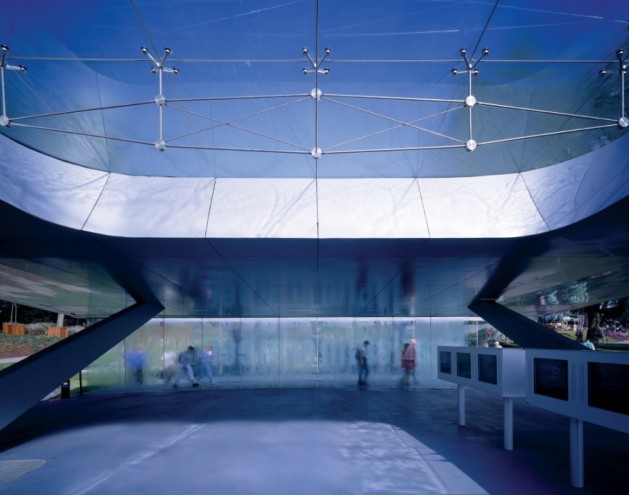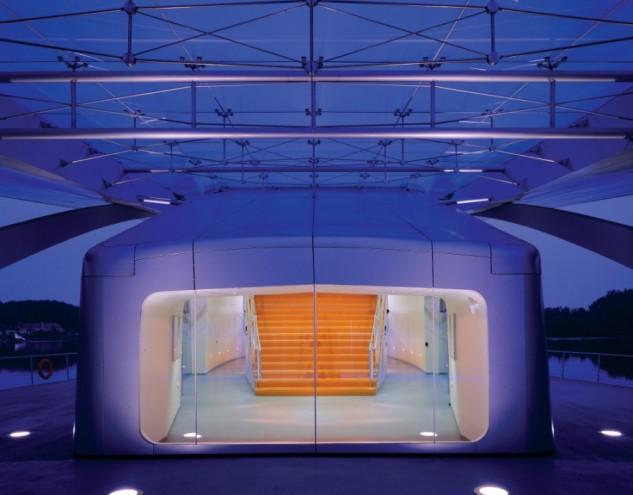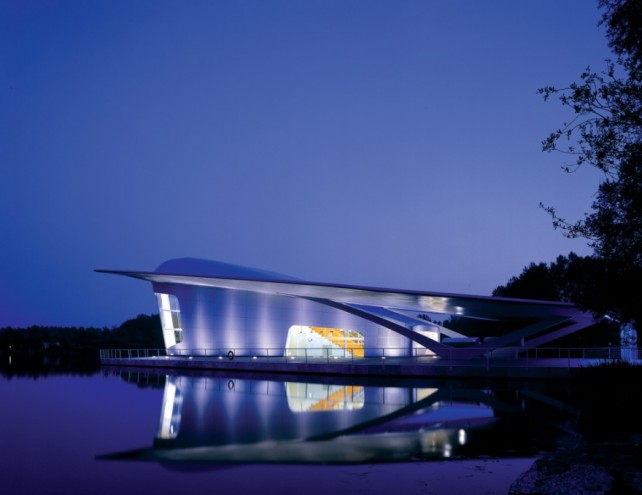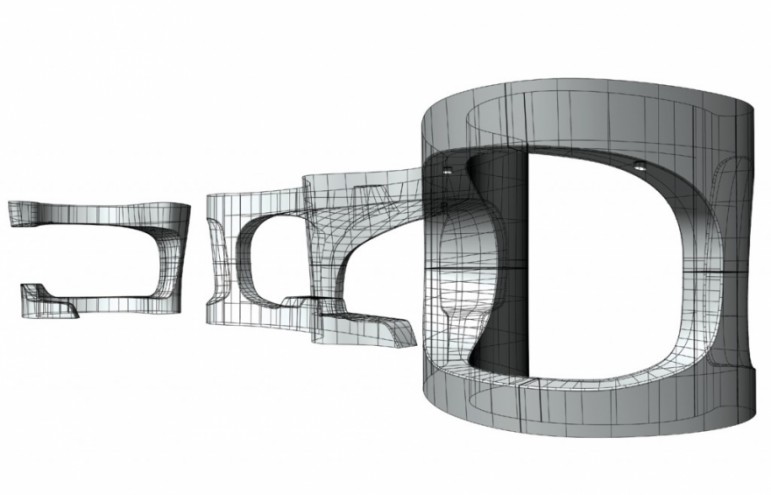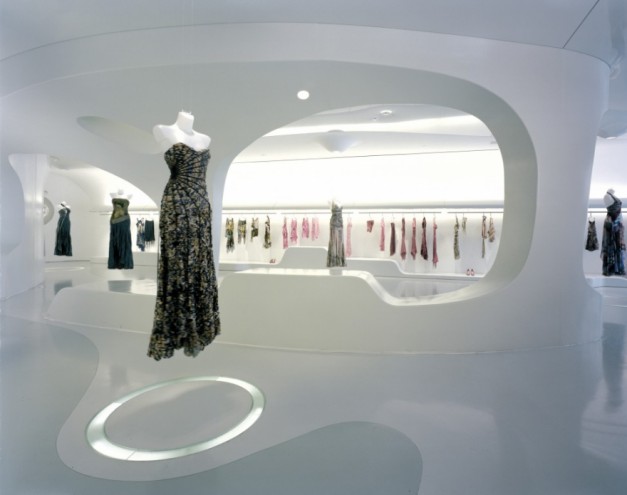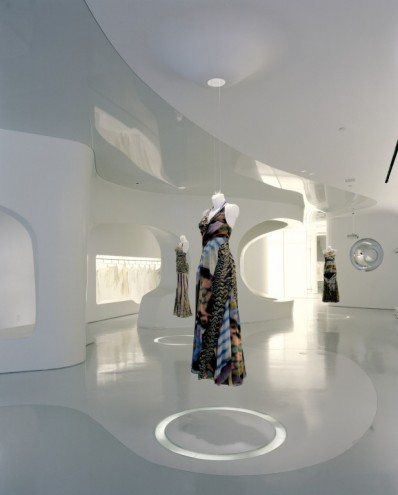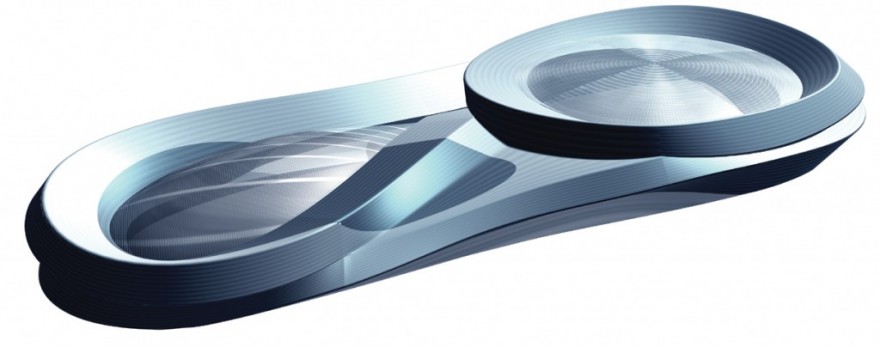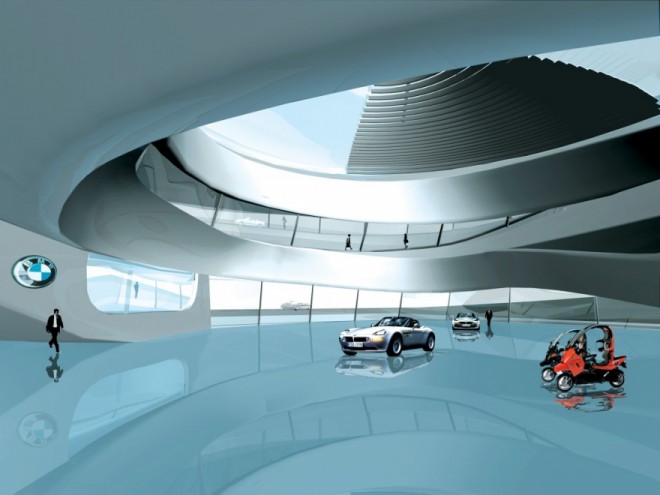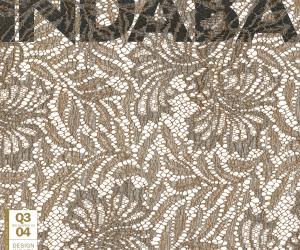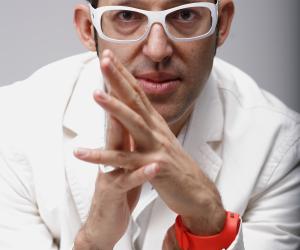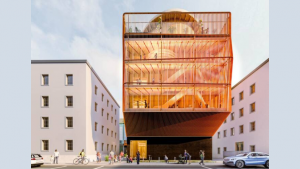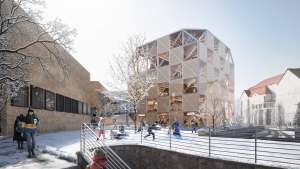First Published in
I have never really interviewed you but we have on numerous occasions discussed design, art, architecture, and cultural issues on many levels over the years. One question that I am always asked and I am curious of your answer is, "How did you pass the stage from a young dreaming child to an architect?"
I believe part of me is still passing through that stage... and the other part was accomplished by a combination of being very inspired by our father and his work as a sculptor, painter and set designer; another by working through two degrees in architecture, another by meeting and working with Lise Anne Couture (who is my partner in every aspect of my work and life), and another by apprenticing under Daniel Libeskind in the mid 1980s, and finally by going head first into a private practice in New York as soon as I could at the age of 27.
And what were your first memories of the awareness of design and our built environment?
Probably the cathedrals in London and Rome that dad used to have us draw with him when we were not even five, and the frequent visits to his studio where he always seemed busy on amazing creations. And then my very fond and strong memory of Expo 1967 in Montreal when we immigrated to Canada. I felt as if we were exposed to the "future" in vivid clarity and fidelity.
Did you like childhood? Growing up what was your strongest memory about the future?
I loved childhood - we were together all the time, you and I, because of how frequently we moved around as a family. I once counted - between Cairo, Algiers, Rome, London, Montreal and Toronto, we lived in five nations before I was eight and you six .... so that was one strong memory about the future, that it would be global and diverse. I remember fondly the Mini Cooper that Mom had brought to Cairo from London and with that took us all out of Egypt where Dad wasn't terribly happy, I suppose. That car and the fact that our very headstrong British mom used it as a kind of Bond-like escape vehicle also left a deep impression on me about the surreality that the future might hold - especially when the car dived into the river in Algeria and was carried out with us in the back seat thinking we were in a car that morphed from car to submarine and then to airplane as we were helped up by local villagers and transported to dry land!
How do you feel about today's contradictory phenomena of our shrinking world - on the one hand everyone is drinking the same coffee , driving the same car (the global village) and, on the other hand, the internet and digital technologies are affording us a customisable personalised world?
For me the world is inevitably moving towards a position of rest where market capitalism is the driving force. It's true that Starbucks, McDonalds, Airbus and Nike are pervasive, as is marketing and branding. It is also the case that companies like IKEA and Microsoft continue to be the largest in the world, spawning the two richest "men" in the world, on the premise that they offer personalisation and specificity to consumers. Images of Sheiks in Dubai stashing Scandinavian furniture into the trunks of German-made cars amaze and amuse me. I think it's unfortunate that for all the promise that the web offered in the way you describe, it has not really panned out. Nike's personalised shoe designs are more of a marketing fad than really ground breaking and CNN is the busiest news site in the world - despite so much information being available elsewhere, and ultimately people fall into patterns of consumer culture that we have seen played out over and over again. Forgive me for saying so, but Target is a souped-up Walmart, just tapping into a savvy marketing scheme where people feel they are expressing individuality, but ultimately all are owning a Graves kettle or clock. What it comes down to is that the middle can feel like the top, and the top has access to real mass customisation, at least that's the impression I get from the way things are marketed and manufactured "globally".
Is there room left in this truly global community for different regions to possess a sense of individual character and personality?
What is really interesting to me in this dilemma (as some would define it) of the global versus local is the fact that what we are really experiencing is the growth and metamorphing of culture. Historically all culture is the result of hybridisation and, one could even say, contamination. And even though it's tough for me personally to be in a cab in Amsterdam and hear hardcore gangster rap from New York, it's in many ways inevitable. Every important moment in history, every culture and period has defined itself by the "input" that is sustained from outside. It just so happens that the global village of McLuhan's time is now on steroids and the rate at which information moves, and by extension contamination and influence take place, is heading towards the instantaneous. And as a global community, we will see both positive and negative ramifications. Ultimately the real potency is as history has taught us, when the local coalesces with the importation and a potential for a new culture emerges.
Since Indaba focuses on all the applied arts, what is your opinion about furniture design today? And more importantly, what is your opinion about graphic design?
I am pretty inspired by much of what I see in furniture and graphic design these days. I think computing has had a terrific impact on all aspects of the applied arts and furniture and graphics both have moved forward in substantial ways. It always intrigued me when Photoshop became pervasive, as to how everyone became a graphic designer (even ads in supermarkets for baby sitters were "designed" and printed at home) and this I think pushed graphic designers to rethink their discipline, and the results are fascinating. One can already see a similar thing happening to furniture and inevitably architecture as packages for 3D modeling and home design software are proliferating, and a certain expertise with it. Add to that 3D printers, and the applied arts in terms of spatial and 3D work are in a whole new territory vis a vis expertise and facility. A return to craft will probably not take place, but what will is ever more radical work that pushes the definition of what actually makes an expert designer, architect and so on. That is what I feel you and I and a number of our colleagues in both our worlds are up to...
Having seen and designed in many parts of the world, do you believe in the concept of international design?
Absolutely, design is a reflection of human desire and need. And as we move deeper into what I like to think of as the steroid-infused global village, we are moving deeper and deeper into an "international" situation when it comes to design. We all manoeuvre through similar terrain when it comes to media and technology and that is obvious when I see digital DTV dishes on apartment buildings in Casablanca, Audi dealerships all over Beijing and slick "over designed" skyscrapers in Dubai. Having said this, what does interest me are the nuances of difference that begin to become visible within the "international blur". And its culture, climate and history that serve as the agents that put the "international" in turmoil. The tension between the two in any given situation is where real design takes place.
Everyday I live I believe that we could be living in an entirely different world - one that is full of real contemporary inspiring objects, spaces, places, worlds, spirits, experiences. Design has been the cultural shaper of our world from the start. We have designed systems, cities, industrialisation - we designed everything. My real desire is to see people live in the modus of our time, to participate in the contemporary world, and to release themselves from nostalgia, antiquated traditions, old rituals, the kitsch and the meaningless, and that we should be conscious and sensorially attuned with this world in this moment. Your work and your pedagogy is very responsive to this notion. If human nature is to live in the past - to change the world is to change human nature. Do you agree?
I have to refer to my answer on the issue of the international. For me the intriguing moment is in the cross-contamination of the new and culture. I don't believe that human nature changes very quickly. In fact, to look around it seems to me that we as human beings continue to trample on old ground - having forgotten lessons from the past, we build ridiculous walls, fight meaningless wars, force our beliefs on each other, become myopic and racist and all this despite having seen where it has led to in the past. So for me the intriguing possibility is not so much in changing human nature, but rather inflecting it. By that I mean that design and, for that matter, any cultural activity has the potential to teach, to convince, to re-establish and, therefore, to inflect. I do believe that we as human beings forget too quickly and therefore human nature is immutable.
You are very much a neophiliac when it comes to technology - I was always inspired and impressed in the eighties when I would visit you in New York and you would proudly show me some new technology, new software, or a beautiful new digital drawing that you had created - my fondest memory was when you would be working on Photoshop creating a visual arbiter and you would click a button to create a task, and we would make espresso and drink it before you could do the next task since you created such beautiful work on such slow machines. Do new technologies inspire your work?
Yes, very much so. The reason is that I am constantly amazed by the ways in which tools, methodologies and means become obsolete. On the other hand, new for newness' sake is something I am not too interested in. For me a technology that really alters the way we think is worth the time it takes to master it, even if that means time for a small lunch between keystrokes and operations.
Uniqueness is one of my favourite subjects - I love the idea of producing 1 million of an object, but at the same time I love the concept of each person's relationship with it being the uniqueness - in other words it's a visceral and cognitive relationship with a thing that makes it his or hers. "Architecture is forever unique" - should it be, or should it be more industrialised?
It is interesting that for the last 150 years the holy grail for architecture has been industrialisation. Every architect dreams of a mass-produced product, and every architect who attempts this fails miserably. Again, if one were to lift the veil of amnesia momentarily, we would see that Le Corbusier's Plan Voisin is now the decrepit low-income housing blocks throughout the US and Europe. That Levittown, the mass tailorised housing concept has left us with infinite tracts of uninspired, dismal suburban housing developments, which are today finally being understood for their destitute condition on the level of human interaction and culture. I too am lured by the prospect of mass producing a housing type, while knowing full well that anything that emerges in this way will probably end up relegated to the scrap heap of bad ideas when applied en masse. The beauty of architecture is probably the fact that each act is ultimately a unique one, something well understood in any mathematically-based art form, be it abstract painting or music.
Architecture has finally proven itself as a means of business - Bilbao has created wealth in an unknown town, Selfridges in Manchester has had record sales, and the list goes on. It seems like the world, business and consumer have finally embraced more radical architecture as a reality and the landscape seems to be changing - these buildings are our new urban landmarks. Has architecture finally reached the masses?
The Crystal Palace, numerous World Fairs and Olympic planning and buildings.... there is a long list of building types and architectures that have indeed reached the masses. It is interesting that in any given period, these "types" of buildings reflect the period in which we are in. So yes, it's no accident that museums and shopping centres have resonated with mass culture and business interests. Although I am not sure what that says about the time in which we live, where the most "populist" art forms in architecture tend to be about commerce and marketing (even museums are about this today) as opposed to a time when the draw would have been simply technology, or the future. I am curious about the next wave of mass appeal architecture which might have something to do with health and environment (or Blade Runner or Logans Run - spectacle and death!).
Tell us more about the Flux pavilion you designed in Bologna - is it a new way of looking at spaces? Or a new way of developing ceramics as technological conductors or "smart ceramics" - cermets?
Well both, obviously. We are always primarily interested in new ways of inhabiting and experiencing space, and to that end the use of electronically infused ceramics is a very interesting prospect. We thought that if you were to experience a stable, solid entity (and there is nothing seemingly more stable than a "stone"-based material like ceramics) and that material can accommodate inputs and induced effects, then it would serve to destabilise the seemingly stable architecture and the experience of a fluid, transformational structure that ultimately responds to your input through occupancy, would be intriguing. The only problem is that our desire for such a material seems years off.
Please explain the Venice Biennale. I am really excited to see your work and planning, and I look forward to visiting this fall.
The designs for all the exhibition areas by Asymptote are inspired by historic and contemporary influences and readings of these historically loaded environments. The Arsenale in particular has a colourful history as a place once used for naval ship building and the manufacture and preparation of kilometres of rope for the sails for the impressive Venetian ships of the 16th, 17th and 18th centuries. Asymptote's transformation of the Cordiere in particular is predicated on a modulating spatial sequence developed by producing a morphing animation involving the actions of torquing and "stringing" the entire space. By utilising the resulting "key-frames", a sequence of elements with the potential to be used as wall surfaces and platforms resulted. These resulting forms and surfaces were further designed to accommodate models, drawings and video for the Metamorph exhibition. The displayed works that move along these "trajectories" form a terrain of tendencies and formations as opposed to being simply displays. The experience of the exhibition is therefore spatial, and acts itself as an architectural entity celebrating ideas, scale, form and meaning.
Lastly, what are your present projects?
Lise Anne and I are working on a number of projects including the design of the 9th International Venice Biennale of architecture, a Crematorium in Holland, and a master planning project in Kuala Lumpur for a housing and office complex. And there is a technology centre in Hamburg that's moving into the construction phase, plus a large commemorative tent structure for the city of Odense in Denmark as the main event space for the Hans Christian Andersen 200 year celebration in 2005. Other than that, there is a very passionate ongoing project to stay sane and spend time with and nurture our son, the next generation, Tynan Couture-Rashid.
About the architect
Hani Rashid founded the architectural practice, Asymptote, in New York City (1998) with Lise Anne Couture. Asymptote is an internationally recognized firm that has produced an extensive body of work including the Guggenheim Virtual Museum and a Virtual Reality Trading Environment and Advanced Operations Center for the New York Stock Exchange.

